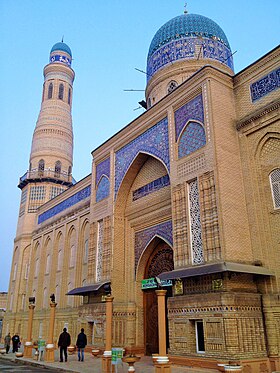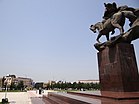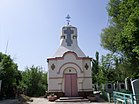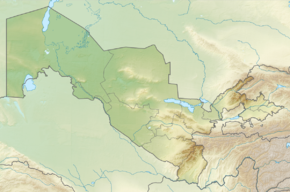
Back أنديجان Arabic Əndican Azerbaijani Андижан Bashkir Андыжан Byelorussian Андижан Bulgarian আন্দিজান Bengali/Bangla Andijan BS Andidjan Catalan Андижан CE Andijon (kapital sa lalawigan sa Uzbekistan) CEB
Andijan
Andijon / Андижон Андижан | |
|---|---|
City | |
Above: Devonaboy Jome Mosque, Second: Statue of Z.M. Babur, Andhjan Chapel of Saint George, Third: Andijan State University, Zubayr Ibn Avvom Jame Mosque, Bottom: Panoramic view of Navoi Square (all relative items are left to right) | |
| Coordinates: 40°47′N 72°20′E / 40.783°N 72.333°E | |
| Country | |
| Region | Andijan Region |
| First mention | V-IV BC |
| Government | |
| • Hokim | Bakhromjon Khaydarov |
| Area | |
• Total | 74.3 km2 (28.7 sq mi) |
| Elevation | 500 m (1,600 ft) |
| Population (2024) | |
• Total | 747,800 |
| • Density | 10,000/km2 (26,000/sq mi) |
| Time zone | UTC+5 (UZT) |
| • Summer (DST) | UTC+5 (not observed) |
| Postal code | 170100[1] |
| Area code | +998 74[1] |
| Website | www |
Andijan (/ˌændɪˈdʒæn, -ˈdʒɑːn/ AN-dih-JAN, -JAHN), also spelt Andijon (Uzbek: [ˌændɪˈdʒɒn]) and formerly romanized as Andizhan (Russian: Андижан [əndʲɪˈʐan]), is a city in Uzbekistan. It is the administrative, economic, and cultural center of Andijan Region.[2] Andijan is a district-level city with an area of 74 km2 (29 sq mi).[3] Andijan is the most densely populated city with density of 10,000 people/km2 and it had 747,800 inhabitants in 2024.[4] Andijan is located in a tense border region at the south-eastern edge of the Fergana Valley near Uzbekistan's border with Kyrgyzstan.[5]
At more 2,500 years in age, Andijan is the oldest city in Uzbekistan[6] and one of the oldest cities in the Fergana Valley. In some parts of the city, archeologists have found items dating back to the 7th and 8th centuries B.C.E. Historically, Andijan was an important city on the Silk Road.
The city is perhaps best known as the birthplace of Babur who, following a series of setbacks, finally succeeded in laying the basis for the Mughal dynasty in the Indian subcontinent and became the first Mughal emperor. Andijan also gained notoriety in 2005 when government forces opened fire on protestors, killing hundreds in what came to be known as the Andijan Massacre.
Andijan was developed into an important industrial city during the Soviet era. Manufactured goods produced in the city include chemicals, domestic appliances, electronics, foodstuffs, furniture, plows, pumps, shoes, spare parts for farming machines, various engineering tools, and wheelchairs.
Andijan experiences frequent seismic activity and was destroyed by a large earthquake in 1902.[7] This was the worst earthquake to occur in Uzbekistan in the 20th century.[8]
- ^ a b "Andijan". SPR (in Russian). Archived from the original on 30 August 2017. Retrieved 3 April 2014.
- ^ "Classification system of territorial units of the Republic of Uzbekistan" (in Uzbek and Russian). The State Committee of the Republic of Uzbekistan on statistics. July 2020.
- ^ Andijan city, Andijan region
- ^ "Hududlar bo'yicha shahar va qishloq aholisi soni" [Urban and rural population by district] (PDF) (in Uzbek). Andijan regional department of statistics.
- ^ Laurelle, Marlene (2015). Globalizing Central Asia: Geopolitics and the Challenges of Economic Development. p. 126.
- ^ https://uzbekistan.travel/en/o/a-facecard-of-andijan-devonaboy-mosque/ Retrieved at 11.51 on Friday 17/5/24.
- ^ "Andijon | Andijon | Uzbekistan, Silk Road, Fergana Valley | Britannica". www.britannica.com.
- ^ "Europe and Central Asia Risk Profiles" (PDF). World Bank.






